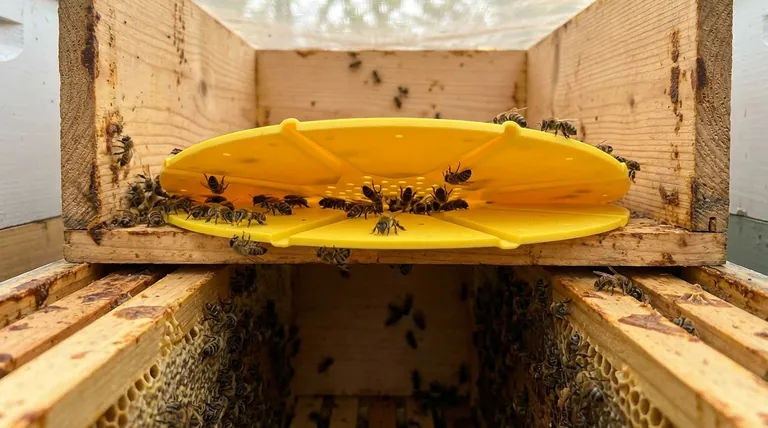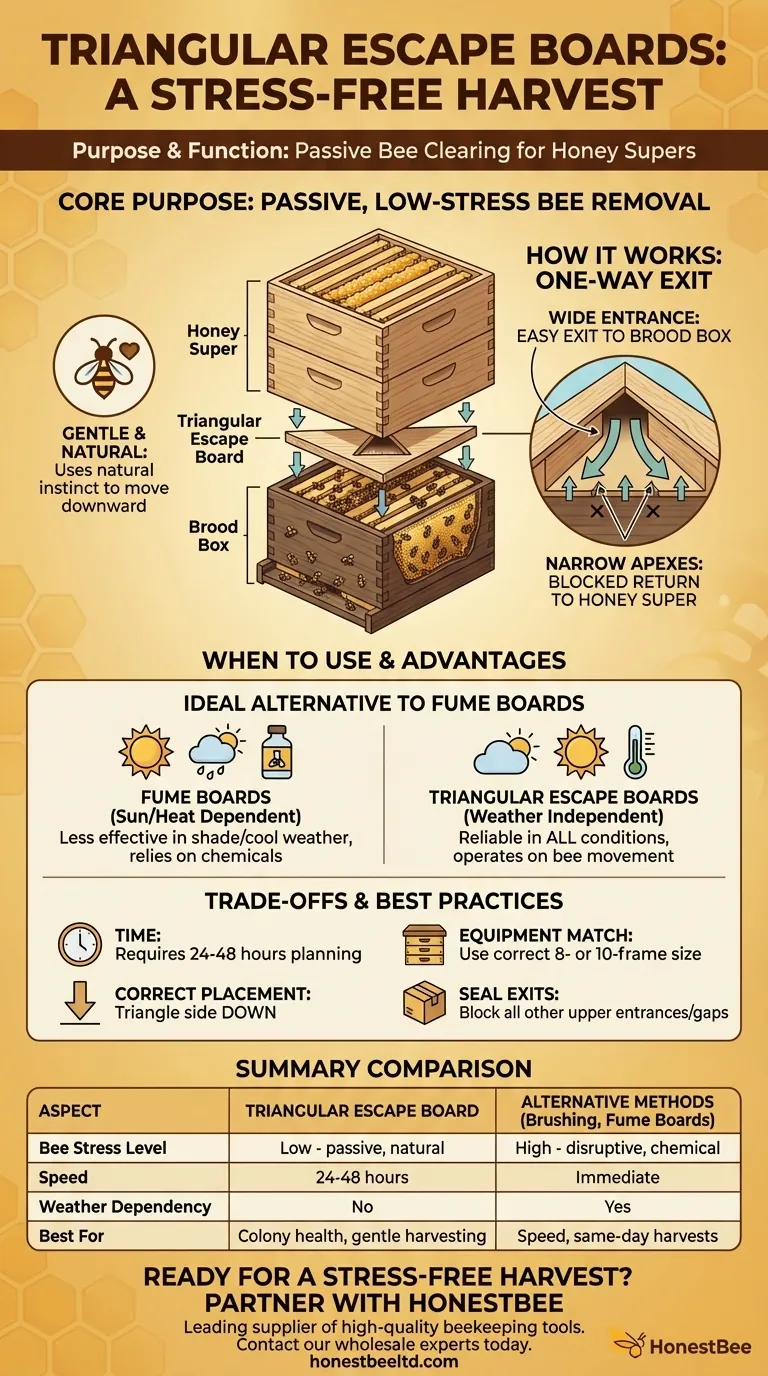At its core, a Triangular Escape Board is a specialized tool used by beekeepers to clear bees from honey supers before a harvest. Its purpose is to provide a passive, low-stress method for removing bees by creating a one-way exit, allowing them to move down into the brood box while preventing their return.
The Triangular Escape Board leverages the bees' natural instinct to move within the hive. It provides a simple, gentle way to empty honey supers without the disruption of brushing or the chemicals used in fume boards, making it an ideal choice for a calm and efficient harvest.

How a Triangular Escape Board Works
A Triangular Escape Board is placed between the honey supers (the boxes you intend to harvest) and the brood chamber below. The bees in the super, seeking to rejoin the colony in the brood box, travel down through the board.
The Principle of One-Way Travel
The board features a distinctive triangular passage on its underside. Bees can easily find the wide entrance of this triangle and walk through it to exit into the brood chamber below.
However, if they try to return, they are faced with the narrow apexes of the triangle. These tiny exit points are difficult for them to locate from underneath, effectively blocking their re-entry into the honey super.
A Stress-Free Method
Unlike shaking bees off frames or using fume boards with chemical repellents, the escape board works slowly and quietly. It allows the bees to move at their own pace, significantly reducing stress on the colony.
This passive clearing process typically takes 24-48 hours, after which the beekeeper can return to find largely empty supers ready for a clean and simple harvest.
When to Use a Triangular Escape Board
While it can be used in most harvesting situations, the Triangular Escape Board excels in specific scenarios where other methods fall short.
An Alternative to Fume Boards
Fume boards rely on heat and direct sunlight to vaporize a repellent that drives bees downward. In shady, cool, or cloudy conditions, fume boards are far less effective.
The Triangular Escape Board, however, operates independently of the weather. It functions based on bee movement, not chemical activation, making it a reliable choice on days without strong sun.
Understanding the Trade-offs and Best Practices
While highly effective, using an escape board correctly requires a bit of planning and attention to detail. Understanding its limitations is key to success.
The Primary Trade-off: Time
The most significant trade-off is time. This is not an instant solution. You must install the board at least a day or two before you plan to pull the honey supers. This requires planning ahead.
Correct Placement is Crucial
The board must be installed with the triangle side facing down, toward the brood boxes. If placed upside down, the bees will simply be trapped in the super.
Ensure Your Equipment Matches
Triangular Escape Boards come in sizes that correspond to standard hive equipment, most commonly 8-frame or 10-frame sizes. You must use a board that matches your box size to ensure a proper fit and prevent bees from bypassing it.
Seal All Other Exits
For the board to work, it must be the only way for bees to travel between the super and the brood box. Make sure any upper entrances on the hive are closed and that there are no cracks or gaps in the supers that would allow bees to fly in and out from the outside.
Making the Right Choice for Your Goal
Deciding whether to use a Triangular Escape Board depends on your priorities for the honey harvest.
- If your primary focus is a fast, same-day harvest: You might consider brushing bees frame-by-frame, though this is highly disruptive.
- If your primary focus is colony health and minimal stress: The Triangular Escape Board is the superior choice, provided you can plan 24-48 hours ahead.
- If your primary focus is harvesting on a cool or cloudy day: The Triangular Escape Board is significantly more reliable than a fume board.
By planning ahead and using this simple device, you can ensure a calm and effective harvest that respects the natural behavior of your bees.
Summary Table:
| Aspect | Triangular Escape Board | Alternative Methods (e.g., Brushing, Fume Boards) |
|---|---|---|
| Bee Stress Level | Low (passive, natural movement) | High (disruptive, chemical exposure) |
| Speed | 24-48 hours (requires planning) | Immediate (same-day harvest) |
| Weather Dependency | No (works in any condition) | Yes (fume boards need sun/heat) |
| Best For | Colony health, gentle harvesting | Speed, same-day harvests |
Ready for a Stress-Free Harvest? Partner with HONESTBEE.
As a leading supplier of beekeeping supplies and equipment for commercial apiaries and distributors, HONESTBEE provides the reliable tools you need for a successful season. Our high-quality Triangular Escape Boards are designed for durability and effectiveness, helping you protect your investment—your bees.
Let us equip your operation for a more efficient and bee-friendly harvest. Contact our wholesale experts today to discuss your needs and place your order.
Visual Guide

Related Products
- Efficient Hive Clearing: HONESTBEE 8-Way Plastic Bee Escape
- Slatted Porter Style Bee Escape for Rapid Hive Clearing
- Circular Labyrinth Bee Escape for Efficient Hive Management
- HONESTBEE 4-Way Metal Corner Wooden Bee Escape Board
- Heavy Duty Metal Corner Bee Escape for Reliable Hive Clearing
People Also Ask
- How is the Triangle Bee Escape Board placed when removing a super? Master the Correct Placement for a Stress-Free Harvest
- Where should the triangle escape board be placed in the hive? Master a Gentle, Stress-Free Honey Harvest
- What is the correct orientation for placing Triangular Escape Boards? Ensure a Stress-Free Honey Harvest
- How long should a bee escape be placed before harvesting honey? The 24-48 Hour Guide to a Stress-Free Harvest
- What is a bee escape board and how does it help in harvesting honey? A Gentle, Chemical-Free Harvesting Solution



















